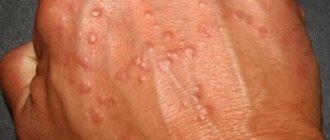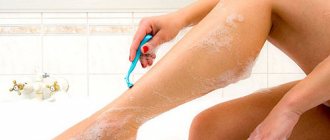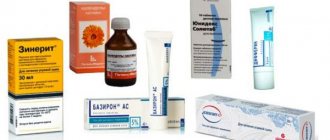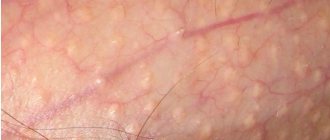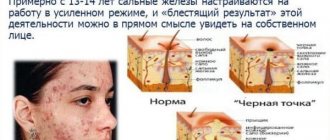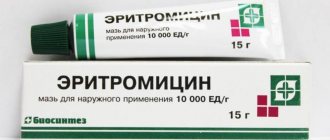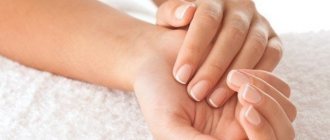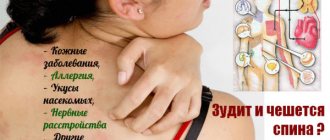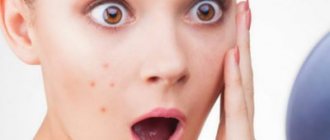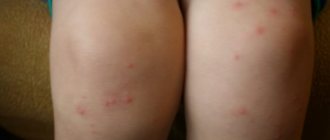Pimples on the hands never appear out of nowhere - there are reasons for their occurrence that need to be clarified before starting therapy. Provocateurs of such a symptom can be both physiological processes occurring in the body and some external factors.
But a very dangerous situation is when the formation of areas covered with rashes is caused by pathological processes. At the same time, pimples on the fingers can appear not only due to dermatological diseases, but also against the background of disruption of the functioning of internal organs or entire systems.
We will find out all the possible factors that provoke this symptom. The treatment of the rash on the fingers will depend on what exactly caused it.
Causes of rashes on hands
Rashes on the hands can appear as a result of various processes. The most commonly diagnosed causes are:
- Allergic reaction;
- Diseases of infectious etiology;
- Diseases of a fungal nature;
- Violation of the body's metabolic processes;
- Genetic pathologies;
- Changes in hormonal levels;
- Diseases and conditions caused by various nervous disorders;
- Failure to comply with personal hygiene standards.
Let's look at each of these reasons in more detail.
Allergic reaction
The manifestation of allergies in the form of pimples between the fingers can occur as a result of contact with various irritants.
This can be food, aggressive household chemicals, unnatural types of fabrics, pollen of some plants, animal hair and many other sources. The factors that cause allergies are so diverse that it is not always possible to independently determine the cause.
Special tests will help identify all allergens that can affect the appearance of pimples on the hands.
Diseases of infectious etiology
Among the diseases accompanied by the appearance of acne that itch are:
- Rubella - the rash appears in the form of pink spots or papules, in addition, with rubella the lymph nodes become enlarged;
- Measles - in addition to papular or spot-like rashes, is characterized by an increase in body temperature, silty intoxication of the body and inflammatory processes in the oral cavity and respiratory organs;
- Chickenpox - the formation of a papulovesicular rash is accompanied by a febrile state.
The development of these diseases, as a rule, occurs against the background of a deterioration in the patient’s general well-being.
Diseases of a fungal nature
Infection with various fungi occurs most often in the presence of even the smallest wounds and microcracks on the skin.
Once inside, bacteria penetrate deeper, damaging tissues and causing inflammatory processes. In this case, pimples are localized near the affected area, located in groups. They itch and turn red, causing discomfort to the patient.
Violation of the body's metabolic processes
Impaired metabolism can be caused by diseases of the gastrointestinal tract or a general imbalance in the body.
If we talk about the last option, then its appearance, in particular, can be influenced by many factors, including a weakened nervous system.
Genetic pathologies
If acne is inherited from parents, then it may not respond to any therapeutic methods for a long period of time, continuing to spread throughout the entire skin.
Hormonal changes
An increase or decrease in the content of certain hormones can cause various rashes, including on the hands. Most often, hormonal surges are observed during puberty or during pregnancy.
Such processes are due to the fact that during this period of time the sebaceous glands function extremely actively, the skin, in turn, is not able to cope with the excess volume of fat, as a result of which the ducts of the epidermis become clogged, which causes the formation of acne.
Diseases and conditions caused by various nervous disorders
Severe nervous tension or resulting stress often results in disruptions in the functioning of various internal organs.
And already developing diseases manifest themselves, among other things, in the form of acne on the patient’s hands. In this case, rashes are not the only signs of the disease, but are only one of several striking symptoms.
Failure to comply with personal hygiene standards
Since bacteria have a high reproduction rate, it will not be possible to destroy them without using hygienic methods.
If you systematically neglect basic hygiene standards, the skin will become a favorable environment for bacteria to attack and for their development and reproduction. This is justified by the fact that human hands are in greatest contact with a variety of objects and surfaces that are in public use.
Microbes, once on the epidermis, will almost certainly cause itching and rashes.
Treatment
When the first unpleasant symptoms appear, the question arises of how to deal with them and how to treat them. A specialist can answer it. It is necessary to undergo an examination by a dermatologist and pass all the necessary tests. After this, the doctor will be able to determine the diagnosis and prescribe effective treatment. It will depend on the etiology of the cause that caused the rash.
Subcutaneous acne
This type of rash can appear under many circumstances.
Darier's disease can be called the most dangerous for the patient. This disease is classified as genetically determined and is transmitted from parents to children.
It should be treated exclusively under the strict supervision of a doctor.
Most often, the treatment course includes taking vitamins such as A and E. If an infection is present, you should take:
- Antibiotics;
- Topical creams;
- Aerosols.
There are several more effective methods for getting rid of subcutaneous acne.
Salt baths
To reduce the number of existing pimples and prevent the appearance of new ones, you should arrange water treatments with sea salt.
To do this, add salt to warm water in a bowl, and after it is completely dissolved, put your hands in there for 15 minutes. You can add sea salt directly to the bath when bathing.
Iodine lubrication
Iodine is applied to the surface of the pimple without affecting healthy areas of the skin - pointwise. Prolonged cauterization or frequent application of iodine can have an undesirable effect, damaging the skin even more.
This method is used if it is possible not to leave the house for several days so as not to attract undue attention from passers-by.
Application of ichthyol ointment
By treating acne on your hands with ichthyol ointment, you can achieve their disappearance due to the antimicrobial effect of the drug. In addition, the ointment has excellent soothing properties.
Lemon juice treatment
To get rid of the discomfort caused by a rash on your hands, you can use this effective method: take the juice of one lemon, mix it with boiled water (you need to squeeze half a lemon into a glass of water). Then the resulting solution is treated with the affected skin.
Types of calluses and treatment methods
Gvozdevaya
A rare type of callus.
Does not have a hole or black spot in the middle.
Outwardly it resembles a nail, the head of which is on top.
It has a small round shape.
Rod
A distinctive feature of this callus is its structure.
The surface of the skin acquires a slight compaction, and under it there is a base.
The main inconvenience is severe pain due to the root located in the tissues.
Such a deep callus can be removed by contacting a medical center for hardware or surgical intervention.
There are several ways to get rid of a callus, for example drilling.
Cryotherapy, as a result of which the callus is frozen, and it dies off on its own.
Laser action that evaporates the liquid contained in the callus, which leads to drying of the rod and the formation itself.
Water
A similar callus can be observed when wearing uncomfortable shoes.
A blister appears that is filled with blood or lymph fluid. The outer skin is thin and easily torn from external influences.
A watery callus should not be pierced or picked off on its own. The treatment procedure is aimed at eliminating mechanical effects at the site of injury.
As a result, the neoplasm will heal on its own, and the contained lymphatic fluid will dissolve and help restore the skin.
Dry
Occurs in various parts of the body. It is a small keratinized part of the skin.
It feels hard and unpleasant to the touch. Treatment should be carried out even in the absence of painful symptoms.
To do this, steam your feet in warm water with various additives such as soda, soap, potassium permanganate or tea tree oil.
Corns
This callus is similar to the one described above.
However, it only appears on the soles of the feet.
It has no definite boundary and varies in size.
The cause of the appearance is general dry skin, frequent walking and wearing hard shoes.
Cone
It appears as thickenings on the big toes. Sometimes it causes discomfort when walking.
The cause may be heredity.
Development occurs for no apparent reason.
Bumps also occur when wearing uncomfortable shoes for a long time.
If the callus is exposed to regular mechanical stress, it can turn into a bunion. This type of callus occurs on the big toes near the joints and contains fluid inside.
The result is severe pain when walking.
Treatment for a bump or bunion should begin by changing your shoes to more comfortable ones. If the callus does not cause pain and does not grow, then there is no reason to worry. But when it becomes a hindrance, you should visit a surgeon.
What can pimples on your hands mean, and how to deal with them?
Acne does not appear on the hands as often as on the face or back, but still some people face this problem. Rashes can be different - it can be either one subcutaneous pimple or a whole scattering of small inflammatory elements. There are also many places where acne can appear: on the hands, on the wrists, on the fingers and even between them. Let's see why they can appear in such atypical places, and how you can get rid of this problem.
What you can do on your own for acne
Therapy includes medications and traditional methods; let’s look at the main ones.
Pharmaceutical preparations for acne on fingers
You can overcome small and large rashes with the help of the following pharmaceutical products:
- vitamin groups of preparations (A, E, C), necessary for skin regeneration and increased immune defense;
- ointments and gels for external use (the prescription of certain drugs depends on the nature of pimples, universal drugs) - Zinc ointment, Sulfur ointment, Vishnevsky balm - these cheap drugs will help get rid of the disease instantly;
- brilliant green for drying weeping rashes, as well as a solution of iodine, potassium permanganate, hydrogen peroxide;
- Clotrimazole, Triderm, Advantan, Protopic - these products are ideal for combating allergic reactions, and antibacterial compounds Levomekol, Levosin, Ficidin are also used;
- in case of damage to the fingers due to a fungal infection, the appropriate groups of drugs are used (Difluzol, Fluconazole, Zalain, Ketoconazole).
Despite the abundance of drugs, the appropriate composition is prescribed by a physician.
Allergic reaction
Our hands come into contact with many irritating substances every day: dishwashing liquid, washing powder, cosmetics - all of this can be a potential allergen. If the rashes are caused by direct contact with an allergen, they will appear only on the hands, and if the problem is intolerance to a food product, then pimples will appear on other parts of the body. The solution to the problem in this case is to avoid contact with the allergen and take antihistamines. You can also use antipruritic ointments, for example:
Infectious diseases
Pimples on the hands can be a symptom of the onset of an infectious disease, such as chickenpox or measles. However, in this case, it’s not exactly pimples that appear on the hands - the rashes are more likely to look like blisters or small blisters. It is easy to identify an infectious disease - it is accompanied by high fever, general malaise, rashes soon appear not only on the hands, but throughout the body. In this case, you need to call a doctor at home.
Internal reasons
Sometimes the cause of acne on the hands can be any internal disease. It could be thyroid disease, metabolic disorders, gastrointestinal problems, or hormonal imbalance. To find out the exact cause, you will need to consult a doctor and complete examination of the body. Only after this will it be possible to determine exactly how to treat rashes on the hands. So, if acne appears due to hormonal changes that occur in a woman’s body during pregnancy, the treatment will be different than when the cause lies in the presence of gastritis.
- Why do pimples appear on the nose, and how to deal with them?
- Pimples on the neck: main causes and tips for eliminating them
- White pimples: how to properly deal with milia that affect the skin of the face
What is a callus?
A callus is a thickening on any part of the human body. It is caused by the regular process of friction of the skin with any object. It often appears on the feet due to improperly selected shoes, hosiery, or due to the special structure of one or both feet.
Callus has two main types.
Depending on the structure, it can be skin or bone.
- The first type is the most common and appears to be a thickened part of the skin. The reason for the appearance is the body’s reaction to close contact with the surface of something.
- Callus differs in its structure. It can appear after a fracture in the form of a new growth from bone tissue.
Dermatological diseases
Sometimes acne-like rashes on the hands appear due to the development of a fungal infection. To prevent their occurrence, treat every wound that appears with antimicrobial agents - the fungus penetrates most easily through all kinds of cracks and scratches on the skin. If you suspect an existing fungus, contact a dermatologist - treatment in this case should be selected according to an individual scheme.
Scabies can also be mistaken for acne. Most often, such rashes appear between the fingers. This disease is also a reason to immediately consult a doctor. Without taking any measures, you endanger not only your own health, but also the health of others, because scabies is a contagious disease.
Insufficiently thorough skin cleansing
If small red pimples appear on your hands, the reason may be very banal - insufficiently thorough cleansing of the skin from existing impurities and dead particles. Such pimples are usually small in size, there are many of them, and they often itch. Such rashes very rarely appear on the wrists and hands. Favorite places are the forearms and elbows. To get rid of the problem, regularly cleanse your skin with scrubs, use a hard washcloth, and moisturize your skin with milk, lotion or cream. If the above measures do not help, you may need to cleanse your skin more thoroughly. You can visit a cosmetologist's office and have deep skin peeling or normalize the activity of the sebaceous glands using darsonvalization.
Possible complications
You should not ignore the problem or self-medicate; even ordinary acne can cause serious consequences. Acne that appears on the heels can trigger the onset of such a serious disease as heel fasciitis. With rashes on the extremities, there is a risk of infection, which can lead to gangrene, and in advanced cases, amputation. Terrible complications can be avoided if you seek medical help in a timely manner and follow preventive measures:
- monitor hand and foot hygiene, use antibacterial soap after visiting public places;
- carefully care for the skin of your feet using moisturizers;
- do not walk barefoot in the sauna or swimming pool;
- lead a healthy lifestyle, give up bad habits;
- eat a nutritious, varied diet, including vitamins and minerals in the diet;
- avoid stress and overexertion.
Skin defects cause aesthetic discomfort and unbearable pain, which changes the usual way of life. You should be attentive to any changes in the body in order to quickly get rid of a delicate problem. Timely medical care and medications will help restore health and beauty to the skin without relapses or negative consequences.
Source: 2Stupni.ru
Lack of vitamins
Often this problem occurs with vitamin deficiency: small pimples appear on the hands, they itch, which causes additional discomfort. You can get rid of them by enriching your diet with healthy foods: nuts, herbs, vegetables. It would also be a good idea to take a course of multivitamins. Taking Omega-3 fatty acids has a good effect - they improve the condition of the skin, helping it stay hydrated, and prevent the occurrence of acne - not only on the hands, but throughout the body.
Lack of rest
Small pimples on the hands can appear due to nervous tension, chronic lack of sleep, overexertion at work, or constant fatigue. Watch your daily routine, try not to get nervous over trifles and spend more time in the fresh air - this will benefit both your skin and your entire body. The appearance of acne on the hands also has a psychosomatic background. It is believed that rashes appear when a person subconsciously tries to isolate himself from society, when he needs to be alone with himself.
Pimples appear on the hands extremely rarely, however, if they have already appeared, you first need to try to determine what exactly caused them to appear. Try to exclude all possible allergens, pay more attention to your diet and daily routine, free your skin from the stratum corneum using scrubs and other cosmetics. If acne is not the only problem, and you have a high fever, you need to urgently seek medical help. It is also worth seeing a doctor if all of the above measures to independently eliminate the problem do not bring results. It is possible that the rashes on your hands are not acne at all, but a fungal infection or other dermatological disease.
Which doctor should I contact for help?
- The main specialist is a dermatologist. However, depending on the nature of the disease, there may be other options.
- In the case of callus, you should seek help from a surgeon. It will also help with purulent, infected and severe calluses.
- In other situations, aesthetic medicine specialists can come to the rescue. Using cryotherapy, laser or hardware drilling, the defect can be removed.
In particularly advanced situations, the intervention of a surgeon and an operation may be required, which will affect the entire life activity of a person and limit the usual physical activity. In addition to laser and surgery, conventional ointments can be used in treatment. But often a person notices the presence of a problem already in an advanced state, which requires a serious approach to recovery.
To effectively combat calluses, their prevention is necessary. In areas most susceptible to mechanical stress, it is worth applying cream in the evenings or gluing a patch when wearing uncomfortable shoes. Socks and shoes on your feet must match in size and be made from natural fabrics and materials.
source
What causes watery pimples to appear on the fingers?
Rashes on the hands are a very common pathology that occurs everywhere in people of any age. Watery pimples on the fingers are of particular concern. What causes them, and what might this symptom indicate? How to deal with it? You will learn about this from our article.
How to treat?
Treatment for pimples on the fingers depends on the cause of their appearance. And to correctly determine the diagnosis, the help of a qualified specialist is necessary. Treatment can take a long time and consist of a whole range of measures:
- taking vitamin preparations, especially valuable for the skin are vitamins A, E, C, which are necessary to increase regenerative function and immunity;
- use of ointments and other medications;
- use of traditional methods.
Hand baths
Baths are made with the addition of sea salt, potassium permanganate, decoctions of medicinal herbs, essential oil of pine or eucalyptus, which are diluted in warm water. This will relieve inflammation, disinfect the surface of the skin, and dry out rashes. The procedure must be carried out daily for fifteen minutes.
Iodine treatment
Iodine must be applied pointwise. Use a cotton swab dipped in iodine solution to treat the surface of the pimple. Iodine dries out inflamed and purulent formations well and has a disinfectant effect.
Treatment with ichthyol ointment
I lubricate the affected area with ointment. “Ichthyolka” has a strong antibacterial effect and has a calming effect on irritations and inflammation.
Lemon juice treatment
The juice of half a lemon is diluted with a glass of boiled water, the resulting solution is applied to pimples on the hands or the mixture is used for baths. Lemon cleanses and disinfects the skin, promotes rapid healing. This method is not suitable for people who are allergic to citrus fruits.
Aloe juice
Aloe juice is applied to problem areas twice a day. This method will eliminate itching and inflammation.
Tincture of calendula
Calendula has antimicrobial properties, cleanses and disinfects the skin, and relieves inflammation. Use the tincture to wipe problem areas.
Olive oil
Dry pimples and flaking will be eliminated by olive oil, which softens and nourishes the skin. Instead of olive oil, almond or peach essential oil is perfect. The oil should be heated in a water bath, lubricate problem areas and wear plastic gloves. After half an hour, the gloves can be removed, but the oil layer does not need to be washed off.
What causes watery blisters on hands?
Most often, these rashes form on the hands, fingers and between them. As a rule, exacerbation occurs in the autumn-spring period. The most common disease that causes small blisters to appear on the hands is dyshidrosis. Dyshidrotic eczema (or as we usually call it, miliaria) is a skin disease that is chronic in nature. Dyshidrosis is localized on the lateral surface of the fingers, soles, and palms. The most common cause of such skin manifestations is dysfunction of the sweat glands.
Water pimples on the fingers: provoking factors
The causes of dyshidrosis are varied. These may be external factors: a reaction to powders, detergents and cleaners, frequent prolonged contact with water. It can also be internal factors: neuro-emotional stress, foci of chronic infection, food allergens. Treatment for this disease should be comprehensive: a combination of sedatives, antihistamines, desensitizing drugs, as well as external therapy. Please note: if the disease has a chronic course (that is, blisters regularly appear and disappear), then external therapy alone does not have an effect, so complex treatment is required.
Causes
Symptomatic treatment of pimples brings only short-term results. To deal with a problem, you need to identify and eliminate the root cause of its occurrence. Water pimples on the hands indicate the appearance of skin pathologies, malfunctions of vital organs, exposure to external factors, etc.
Scabies
If small, watery pimples on your hands itch, this indicates that scabies mites have penetrated the skin. Clinical manifestations of scabies, in particular, itching and pimples with liquid, are caused by an allergic reaction to the waste products of the intradermal parasite.
Watery pimples on the hands can be caused by an infestation by a microscopic parasite called scabies mites. Infection occurs through contact.
Typical symptoms of scabies include:
- blistering rashes on the arms and torso;
- redness and swelling;
- itching, worse at night;
- whitish-gray stripes on the skin.
Most often, pimples are distributed in the interdigital spaces of the hands. When scratching the skin, bacterial inflammation occurs, causing watery rashes to turn into ulcers. If not treated in a timely manner, pimples spread to the wrist, trays, armpits, chest, etc.
Allergy
With urticaria and allergic dermatitis, the rashes are accompanied by itching, swelling, and hyperemia (redness) of the skin. They occur after contact with an allergen, so pimples are often localized on the hands and open areas of the body - neck, décolleté, face. Allergies are caused by irritating substances:
- dust mite;
- decorative cosmetics;
- household chemicals;
- medicines;
- Food;
- animal fur.
If small, watery pimples on your hands itch, you should consult a dermatologist. Allergic dermatitis and urticaria occur when the immune system malfunctions, which begins to perceive certain substances as pathogenic agents. Therefore, upon repeated contact with them, the body “sends” antibodies - protein substances that neutralize pathogens - to destroy allergens. In this regard, inflammation and pimples filled with clear liquid occur in the skin.
Eczema
Itchy inflammatory elements on the skin are formed with eczema. A weeping rash affects not only the hands, but also any other parts of the body - stomach, legs, neck, face, back, etc. Recurrent disease is caused by the influence of internal and external factors:
- endocrine disruptions;
- renal failure;
- chemical and thermal burns;
- gastrointestinal diseases;
- psycho-emotional stress;
- immune deficiency;
- decreased body reactivity.
Water pimples on the fingers appear as a result of endocrine and metabolic disorders, aggravated by excessive sweating, allergies, and infectious inflammation. Most often, characteristic blisters appear in the area of open wounds, trophic ulcers, fistulas, and deep scratches.
When scratched, the pimples merge, forming large dropsy. If pyogenic bacteria penetrate into them, inflammatory processes worsen. The liquid inside the blisters becomes cloudy and turns into purulent exudate.
Infectious diseases
Watery pimples on the hand are one of the symptoms of infectious diseases.
What causes rashes on feet
» />
Acne and other pimples on the face rarely signal problems that require immediate solutions. Typically, such rashes are provoked by factors accumulated in the body: intoxication, hormonal imbalances, and so on. Changes in the quality of the dermis of the feet and toes most often manifest themselves sharply and in an acute form. And the problems that these phenomena indicate may require urgent medical intervention. Among the provoking factors are:
- infectious diseases;
- allergic reactions, dermatitis;
- psoriasis, eczema;
- cancer;
- other.
Even a person with a medical education cannot always make the correct diagnosis based on the type of rash alone. In most cases, additional laboratory tests are required.
Allergy
The most common and most harmless cause of rash on the feet in men and women is an allergic reaction. It manifests itself as an irritating factor that affects the body both from the inside and outside. When trying to figure out what caused the reaction, don't throw away products you've used before. Indeed, for allergies, the cumulative effect also becomes important, when something that previously did not cause dermatological problems can today manifest itself as a rash. There is no point in diagnosing allergies on your own. It has many faces and can masquerade as other diseases, so it is important not to confuse it with something more serious. With allergic reactions, flaky scales, red spots, blisters and papules may appear on the feet. There may be many or one or two. Itching is also not obligatory, but a possible phenomenon.
Infectious diseases
Some viral diseases manifest themselves as rashes and “pimples” on the skin of the feet and other parts of the body in the early stages. Measles, chickenpox, scarlet fever are an incomplete list of infections that are characterized by rashes on the body. And none of them can be called harmless.
It is therefore important to diagnose the disease in a timely manner and begin treatment. Such diseases are extremely contagious and it is unacceptable to decide how to get rid of their manifestations on the advice of grandmothers and friends. Rashes with such ailments look like red blisters or papules and may itch. Most infectious diseases are characterized by an increase in temperature, a change in the color of mucous membranes, and a deterioration in general health. Therefore, rashes are not the only symptom, but one of the first to appear. It is important not to miss the moment, pay attention to it and seek help from a doctor.
Psoriasis
A disease that occurs in a chronic form, which is characterized by the formation of plaques on skin surfaces exposed to friction, bending, and squeezing. Feet and toes are also at risk. The plaques can be very small and resemble pimples, but they tend to enlarge and merge with nearby lesions. The disease is characterized by alternating acute periods with remissions, but without treatment, the duration of remissions shortens and disappears. And the affected areas increase and the severity of the disease worsens. The acute phase can be triggered by alcohol, stress and other individual factors. There is currently no treatment for this disease.
Eczema
The causes of this disease have not been clarified to this day, so it is not yet possible to cure it completely. It can be provoked by: dysbacteriosis, deficiency or excess of vitamins, malfunctions of the digestive organs, kidneys, weakened immunity and other factors. Eczema spreads, most often, on the extremities, manifesting itself first as itchy redness, and then as blisters on the affected areas. The disease has several stages and types, and each subsequent one is controlled worse and worse. Therefore, timely medical intervention is necessary. The disease most often occurs in a dry form, but sometimes a weeping form occurs, causing even greater discomfort on the feet due to watery rashes.
Some types of lichen
Psoriasis is also a representative of lichen, but there are other types of this disease that are completely different from it. These include:
- Shingles. It is characterized by an increase in temperature with significant lesions, rashes in the form of many watery blisters with cloudy contents, pain and itching in the initial stages;
- Pityriasis rosea. During this disease, spots appear on the skin and rashes in the form of blisters with a red border. Sometimes they are accompanied by slight pain, but they never merge with each other, which is typical only for this type of lichen;
- Lichen planus is a non-contagious disease. Rashes in the form of bright papules are very characteristic and do not cause difficulties for the doctor in diagnosis. After recovery, red spots remain at the site of the rash for a long time.
Each type of lichen has its own treatment, therefore, even if you suspect you have one or another type of disease, consultation with a doctor to prescribe the correct therapy is mandatory.
Mycosis
This name summarizes several types of foot and toe diseases caused by fungi. The insidiousness of this illness is that it appears and disappears for no apparent reason, creating the illusion of recovery. The disease begins with peeling, often in the area between the fingers. Without treatment, it progresses to more severe forms, characterized by a blistering rash in the arch of the foot. Affects nails, changing their shape, structure and sometimes leading to their loss.
Scabies
A contagious disease transmitted by contact with the skin of a sick person. The disease is characterized by a red rash localized between the fingers, on the feet, in the genital area, on the wrists and other parts of the body. It is caused by the scabies mite, which moves under the skin, leaving passages in it. In the evening, microorganisms become more active, causing itching, which is difficult to ignore. Scratching “pimples” leads to secondary infection (for example, staphylococcus). In this case, the “pimples” become purulent and watery.
How to get rid of watery acne on hands
Treatment of pimples is aimed at eliminating the causes that caused their appearance. The treatment regimen is determined by the type of disease that caused the rash on the hands. Particular attention is paid to proper skin care and hygiene procedures. Compliance with sanitary and hygienic rules prevents the formation of new inflammatory elements and the accumulation of pus in the blisters.
Hygiene and care
In half of the cases, itchy pimples are caused by irritants. If redness, blisters or weeping blisters appear, you should immediately stop contact with the allergen.
If the pimples on your hands itch, you should never scratch them! By such actions you can provoke infection into the wounds and get an even bigger problem. Also, you should not pick off the crusts from burst pimples. Over time they will go away on their own.
To speed up recovery processes it is recommended:
- wash your hands with antimicrobial soap;
- treat cuts and small wounds with antiseptics;
- soften the skin with hygiene creams;
- for prickly heat, lubricate your palms with creams with oak bark extract (Natural Healer, Green Pharmacy, Lifebuoy).
If the rash on your hands is caused by allergies, you need to replace your hygiene products with hypoallergenic products.
Drug treatment
The principles of therapy are determined by the reasons for the formation of pimples on the skin of the hands. Treatment of serious pathologies (pemphigus, deep streptoderma) must be carried out in a hospital setting. Special medications are used to relieve symptoms. Some of them are administered by drip or intramuscular injection.
Miliaria, allergic dermatosis, urticaria, eczema, herpes and other infectious diseases are treated with the following pharmaceutical medications:
- antiallergic (Erius, Cetrin, Claritin) – relieve allergic inflammation, obsessive itching and swelling;
- wound healing (Panthenol, Bepanten, Rescuer) - eliminate watery pimples, accelerate skin healing;
- antiviral ointments (Herpeblok, Famvir, Zovirax) - destroy pathogenic viruses, eliminating local manifestations of herpes;
- hormonal ointments (Hydrocortisone, Kremgen, Belogent) - have antipruritic, antiexudative (decongestant) and anti-inflammatory effects for prickly heat, eczema, scabies, neurodermatitis;
- local antibiotics (Tetracycline ointment, Azelik, Bonderm) - eliminate infectious inflammation and purulent pimples on the skin of the hands with streptoderma, microbial eczema, furunculosis.
Watery blisters should be regularly treated with antiseptics and drying agents - Zinc ointment, Diamond green, Ichthyol ointment. For fungal infections of the hands, local antimycotics are prescribed - Itraconazole, Terbinafine, Miconazole, Econazole.
Folk remedies
Alternative medicine offers hundreds of recipes for drying, anti-inflammatory and wound-healing remedies for pimples. To treat the skin of your hands, it is recommended to use:
- Calendula decoction. 2 tbsp. l. dry flowers, pour ½ liter of water and boil for 10-15 minutes. The drained liquid is filtered and taken orally, 100 ml up to three times a day.
- Infusion with aloe. 4-5 fresh leaves are crushed with a knife and pour 200 ml of boiling water. Leave for 2 hours, adding 5-7 drops of mint essential oil. Treat the rash on the hands 6 times a day.
- Compress with a decoction of string. 10 g of raw material is poured into 800 ml of water and boiled for 3-4 minutes. Gauze is moistened in the solution and applied to pimples for 1-1.5 hours up to 4 times a day.
For blistering rashes caused by chemical burns, use propolis ointment. To prepare it you need:
- heat 100 ml of olive oil in a steam bath;
- add 15 g of propolis to the boiling liquid;
- boil for at least 20-25 minutes.
The prepared ointment is used to treat the affected areas on the hands 4-5 times a day. This product not only eliminates pimples, but also prevents bacterial inflammation of the skin.
other methods
For blistering skin rashes caused by dyshidrosis, eczema, urticaria, physiotherapeutic procedures are resorted to:
- electrophoresis - the introduction of antihistamines and anti-inflammatory drugs into the body through direct current;
- transcranial electrical stimulation – enhancing the production of opioid substances by current, affecting the functioning of the endocrine, immune and nervous systems;
- ultratonotherapy – treatment of pimples with sinusoidal current, ensuring restoration of blood microcirculation and increasing local immunity.
To eliminate the symptoms of skin diseases, it is recommended to follow a hypoallergenic diet. Avoiding spices, spicy foods, carbonated drinks and preserves reduces the degree of skin sensitivity to allergens.
To cope with the pathology, you need to consult a qualified doctor. The specialist will select a comprehensive therapy that will help eliminate the problem.
To increase the body's resistance to bacteria or fungi, you need to include foods with vitamins and organic acids in your diet - sea fish, dried fruits, fresh vegetables, dairy products.
Sources
- https://ozude.ru/skin-rashes/pryshhi-na-paltsah-ruk/
- https://dermatitoff.ru/na-paltsah-ruk-poyavlyayutsya-pupyryshki.html
- https://SkinPerfect.ru/pryshhi/vodyanye-na-rukah
Itchy feet and pimples appear: what is it, how to treat it
Pimples on the legs may be itchy or not cause discomfort.
But in any case, their appearance cannot be ignored. The reasons for changes in the skin vary: from minor irritation, which goes away in a couple of days, to serious pathologies of internal organs.
Therefore, when pimples appear on the legs and itch, it is better to check with a doctor if there are no provoking factors.
Non-pathological causes of acne formation
It is necessary to analyze the previous circumstances on the first day the defect appears. It may be enough to eliminate the cause of small acne on the legs, and treatment will not be needed.
Mechanical damage
The skin on the inner thighs is the most sensitive, so when irritated, a red, painful rash appears. Mechanical stress occurs from rough seams of clothing, friction of legs in the summer when sand hits the beach.
Shaving with a machine or epilator
If the procedure is performed incorrectly, the hairs grow in, the skin in this area becomes inflamed, and the small pimples that appear on the legs itch. A seemingly small problem can grow into a complication if an infection gets into an open wound when scratching.
Insect bites
For this reason, red pimples on the legs are most often noticeable after relaxing in nature, but in urban conditions they are not excluded. Insects inject poison, so swelling and itching are possible. Sensitive skin is especially affected.
Diseases that cause itchy pimples on the legs
Skin rashes caused by viruses or autoimmune pathologies must be diagnosed in a clinical setting. The same symptoms may indicate different problems and may not respond to self-treatment. Therefore, if red pimples appear on your legs and itch, it’s worth reading the photos to see how to treat them, but only for general information.
Allergic contact dermatitis
A small rash appears that is very itchy. Provoking factors include: washing powder, caring cosmetics, synthetic clothing fabric, impurities in tap water.
Herpes
First, the skin “tugs”, then the legs itch, and pimples filled with clear liquid appear. The inner or back of the thighs are usually affected.
A yellowish crust forms in place of the burst bubbles. It must go away on its own, otherwise healing will be long and the herpes will spread to healthy areas.
Hemorrhagic vasculitis
This is inflammation of the walls of blood vessels. The symptom is small purple pimples that cover a large area. Then dark spots form in their place.
Hives
Characteristic pimples appear on the legs, like a nettle burn. Their color can range from white to scarlet. Pimples on the legs itch and connect with each other, forming spots. When hives appear on the toes, it becomes painful to walk.
Molluscum contagiosum
An infection, the patient may find out about its infection six months later. The minimum incubation period is 2 weeks. Small nodules with a smooth surface appear on the body. They do not change or increase to the size of a pea. When pressed, a white mass of semi-liquid consistency is released.
Dyshidrotic eczema
The main symptom of the disease is watery blisters. When cracked, they release a clear liquid.
Increased blood sugar
Excess glucose is transported to the skin, causing itching, rashes, and dryness. Symptoms may appear long before diabetes is diagnosed and occur periodically. They are usually expressed as small itchy pimples with unchanged skin color.
Scabies
The causative agent of the infection is a microscopic mite that, when it gets on the skin, makes moves inside and lays eggs. The process is accompanied by the appearance of small watery pimples; they heal quickly, but new ones form nearby. Pimples on the legs itch, causing more discomfort in the evening and at night. The inner thighs, shins, and skin between the toes are most often affected.
Dangerous accompanying symptoms
When red bumps appear on your legs and itch, you need to carefully evaluate your general condition. Heralds of infections or serious pathologies of internal organs, along with changes in the skin, are:
- heat;
- dizziness;
- weakness;
- aching joints;
- enlarged lymph nodes;
- low blood pressure;
- blurry vision;
- swelling of the legs.
In addition, a common allergen can cause anaphylactic shock. And this is already a threat to life.
Drug treatment
For easily removable reasons, you can get rid of the discomfort yourself. The main thing is not to scratch the itchy area to prevent infection.
- When small pimples appear on the legs and itch, relieve the itching by taking antihistamines: Suprastin, Claritin, Erius. Then you need to analyze the circumstances preceding this and identify the approximate cause of the rash.
- After mechanical stress, shaving, or contact with an allergen, you can use medications from your home medicine cabinet. Creams and ointments have bactericidal, healing and analgesic properties: Eplan, Skin-Cap, Radevit, Bepanten. Salicylic acid dries well, but its use is contraindicated for delicate skin. Akriderm cream relieves swelling and eliminates itching.
- For hemorrhagic vasculitis, Prednisolone, Indomethacin, and Cyclophosphamide are taken. At the same time, you need to do self-massage and baths with herbal teas.
- To get rid of molluscum contagiosum, curettage is performed. Moreover, the procedure is allowed at home with sterility and further treatment with iodine. Modern and more comfortable methods are laser removal and cryodestruction.
- For scabies, you need to treat the rash with Sulfur ointment 6 times a day.
- For small red pimples on the legs that itch, it is recommended to apply Fenistil gel and Psilo-balm. You can use hormonal ointments with caution: Flucinar, Advantan, Cloveit.
Self-administration of medications can cause complications if the drug contains components that are allergens for a particular person. The treated area will become inflamed, local swelling will appear, or the general condition will worsen.
If acne on your legs does not go away within 2 days of treatment, or it also itches, you should check with a dermatologist to find out what it is.
Traditional methods
Homemade recipes for some people completely eliminate the problem, while for others they add complications. Therefore, the planned use of any means should be agreed with the doctor, with the exception of treating mild allergic rashes with decoctions of pharmaceutical preparations.
- To eliminate itching and heal small pimples, baths, compresses, applications of chamomile, calendula, nettle, oak bark, string, and sage are recommended. The procedure depends on the location of the pimples. A decoction is prepared from one herb or mixture. Dip your feet into the filtered and cooled liquid or soak a gauze pad and apply to the affected area for 15 minutes.
- For molluscum contagiosum:
- chop the garlic, mix with butter and apply to the nodules;
treat pimples with celandine juice;
- apply a tampon soaked in a saturated solution of potassium permanganate;
- treat with apple cider vinegar.
- For scabies, rub your feet with lard.
- For allergies and hives, it is recommended to take castor oil to cleanse the intestines, and an infusion of lemon balm, linden or mint to calm the nerves.
All of these products are aggressive and can cause burns. When processing, care must be taken to ensure that healthy skin is not touched.
External causes of acne can be excluded if you do not forget about prevention. Increased hygiene, compliance with precautions in public locker rooms will reduce the risk of infection, good cosmetics and detergents, clothing and shoes made from natural materials, a suit for the weather, and shoes that fit properly will prevent allergies and urticaria.
Source: https://VseProZud.ru/zud-tela/nogi/cheshutsya-nogi-i-poyavlyayutsya-pupyryshki
